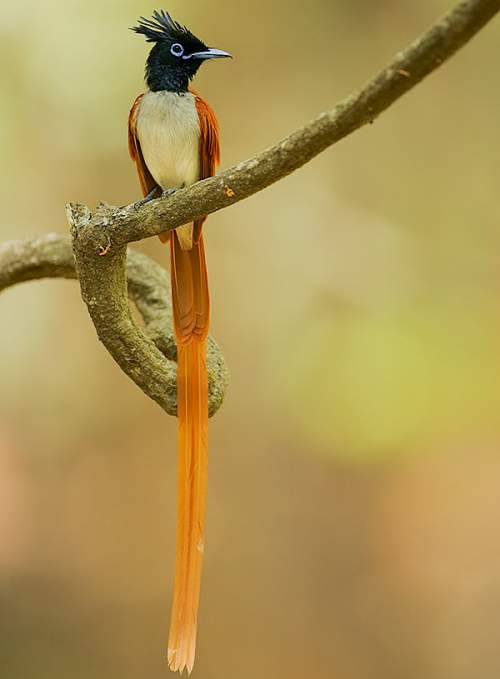The Indian paradise flycatcher (Terpsiphone paradisi) belongs to the family of paradise flycatchers, the Monarchidae.
The Indian paradise flycatcher species is distributed in Indian subcontinent, Central Asia and Myanmar. The adult male paradise flycatchers exhibit plumage dichromatism. These paradise flycatchers are polytypic species.
Appearance, physical description and identification
The Indian paradise flycatcher (Terpsiphone paradisi) is a small sized bird, measuring 20 cm (excluding male’s elongated central rectrices) in length and weighing 17 to 23 grams.The head, face, crown, crest and nape are glossy black. The throat is black in males and gray in females. Adult males develop long tail feathers and the two central tail feathers grow into 30 cm long drooping streamers.
The Indian paradise flycatcher females and young males are rufous and have short tails. The adult males exhibit plumage dichromatism. They are either predominantly bright rufous above or predominantly white.
The bill is black. The irises are black. The males have blue eye-ring whereas the females have black eye-ring. The legs are gray. The call of these paradise flycatcher species is a pleasant, repeated, musical "chie..chie..chie" sound.
 |
| 1.Image of Indian paradise flycatcher - Terpsiphone paradisi by Steve Garvie |
 |
| 2.Image of Indian paradise flycatcher - Terpsiphone paradisi by soumyajit nandy |
 |
| 3.Image of Indian paradise flycatcher - Terpsiphone paradisi by N A Nazeer |
Origin, geographical range and distribution
These Indian paradise flycatcher species are distributed in Indian subcontinent, Afghanistan, China, Kazakhstan, Myanmar, Tajikistan and Turkmenistan.The subspecies T. p. paradisi is distributed in Myanmar, central and south India, Bangladesh, Myanmar and Sri Lanka. The subspecies T. p. ceylonensis occurs in Sri Lanka.
The Indian paradise flycatcher subspecies T. p. leucogaster is distributed in Kazakhstan, Tajikistan, Turkmenistan, west China, north Afghanistan, north Pakistan, north India and Nepal. Non-breeding populations occur in eastern Pakistan and peninsular India.
Ecosystem and habitat
These Indian paradise flycatcher species have low forest dependence. They normally occur in altitudes from 0 to 2000 meters.The artificial ecosystems and habitats of these paradise flycatcher species include heavily degraded forests, rural gardens, plantations, agricultural lands, parks and urban areas.
The natural ecosystems and habitats of these paradise flycatcher species include tropical and subtropical moist montane forests, foothill forests, moist lowland forests, temperate forests, mangroves and shrublands.
Diet and feeding behavior
The diet of these species consists mainly of insects. Flying insects, dragonflies, moths, beetles, winged termites and ants, grasshoppers, crickets, cicadas and locust are their primary food.These paradise flycatcher species glean their prey from foliage as well as flycatch. They forage in undergrowth, lower and middle storeys. Occasionally they are seen flycatching in the canopy.
Reproduction and breeding habits
The breeding season of these Indian paradise flycatcher species is from March to August, with a peak period in May and June, in India and Pakistan. These species are monogamous and highly territorial.The paradise flycatcher nesting sites are located on tree branches. The nest is a compact conical structure. Both the parents take part in nest building. The nest is built with grass, twigs, reeds, moss, leaves, plant fibers and cobwebs.
The clutch contains three eggs. The eggs are incubated by both the parents. The chicks hatch out after 14-16 days of incubation. The hatchlings are care for by both the parents.
Migration and movement patterns
These Indian paradise flycatcher species are partially migratory birds. The subspecies T. p. leucogaster and T. p. paradisi are migratory. The subspecies T. p. ceylonensis is resident and occurs in Sri Lanka.Post breeding, resident paradise flycatcher juveniles may disperse and establish in new locations within the range. Within their range they may make local movements for feeding and breeding.
Indian paradise flycatcher - Quick Facts
- Scientific name: Terpsiphone paradisi
- Species author: (Linnaeus, 1758)
- Synonyms/Protonym: Corvus paradisi Linnaeus, 1758
- Family: Rhipiduridae › Passeriformes › Aves › Chordata › Animalia
- Vernacular names: English: Indian paradise flycatcher, Chinese: 寿带, French: Tchitrec de paradis, German: Hainparadiesschnäpper, Spanish: Monarca del paraíso indio, Russian: Райская мухоловка, Japanese: カワリサンコウチョウ
- Other names: Asian Paradise-flycatcher
- Distribution: Kazakhstan, Uzbekistan, Kyrgyzstan, Tajikistan, Turkmenistan, Afghanistan, Indian subcontinent, Myanmar, China
- Diet and feeding habits: insects, flying insects
- IUCN status listing: Least Concern (LC)
Conservation and survival
The global population size of the Indian paradise flycatcher (Terpsiphone paradisi) has not been quantified. The overall population trend of the species is considered to be stable.In most of its range, this species is reported to be common. The generation length is 5.8 years. Its distribution size is about 6,400,000 sq.km.
Habitat alteration and destruction, agricultural expansion, reduction in insect prey population are the main threats that are endangering the survival of these flycatcher species.
IUCN and CITES status
The Indian paradise flycatcher (Terpsiphone paradisi) does not approach the thresholds for being Vulnerable, either under the range size criterion, or under the population trend criterion or under the population size criterion.The IUCN (International Union for Conservation of Nature) has categorized and evaluated the paradise flycatcher species and has listed it as of "Least Concern".
The CITES (Convention on International Trade in Endangered Species of Wild Fauna and Flora) status is ‘Not Evaluated’ for the Indian paradise flycatcher (Terpsiphone paradisi).
The three recognized subspecies of the Indian paradise flycatcher (Terpsiphone paradisi) are: Terpsiphone paradisi paradisi (Linnaeus, 1758), Terpsiphone paradisi leucogaster (Swainson, 1838) and Terpsiphone paradisi ceylonensis (Zarudny & Härms, 1912).
1.Indian paradise flycatcher image source: https://en.wikipedia.org/wiki/File:Terpsiphone_paradisi_-near_Amaya_Lake,_Dambulla,_Sri_Lanka-8.jpg (cropped)
Image author: Steve Garvie | License: CC BY-NC-SA 2.0 as on 4/25/18
2.Image source: https://www.flickr.com/photos/snandy_81/15099910331/ (cropped)
Image author: soumyajit nandy | License: CC BY-SA 2.0 as on 4/25/18
3.Image source: https://en.wikipedia.org/wiki/File:Asian_Paradise_Flycatcher_(Female)_by_N.A._Nazeer.jpg (cropped)
Image author: N A Nazeer | License: CC BY-SA 2.5 IN as on 4/25/18
Current topic: Indian paradise flycatcher - Terpsiphone paradisi.
